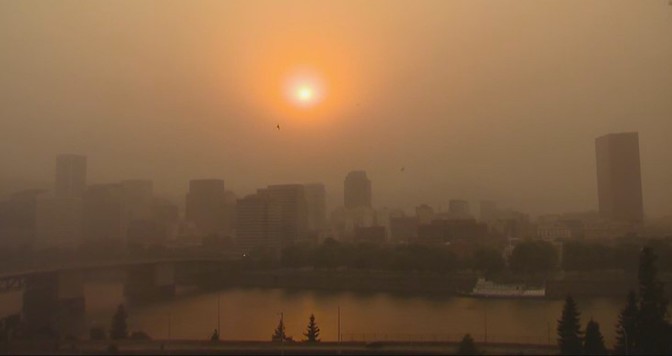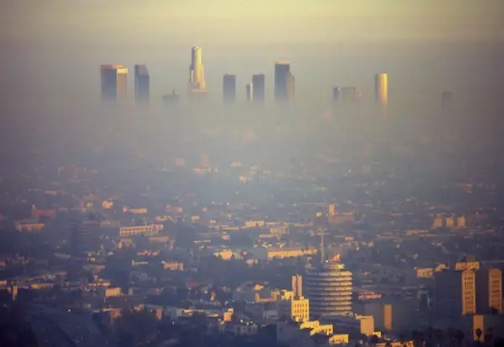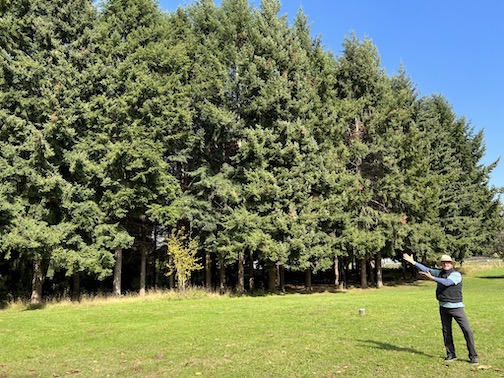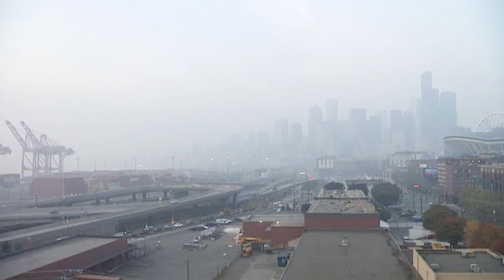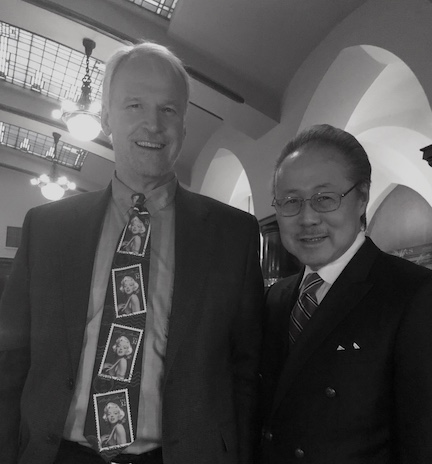Sharing blame requires a pointy finger to wag.
Something happens, plans go sideways, and instead of fun you find disappointment.
You could move on, but what about the unfinished business?
First you need to assign blame. Get that finger ready.
I’m wagging my pointer at the current air quality over Portland, Oregon.
It’s not the worst in the world because of Seattle.
A string of wildfires darkened skies Wednesday and Thursday in the Pacific Northwest, where residents of the normally lush, green region experienced the world’s worst air pollution.
Seattle and Portland, Oregon, were first and second, respectively, in the global ranking of places with the poorest air quality, according to IQAir, a Swiss company that measures air pollution.
The quality was worse than in places like Beijing, New Delhi and Lahore, Pakistan, which more frequently struggle with air pollution.
Who remembers their first exposure to air pollution?
As kids we packed into a Volkswagen camper without air conditioning and went to Disneyland.
My eyes started feeling a burning sensation like sweat dripping in. We were all sweaty, but that wasn’t it.
Los Angeles Air, c. 1969.
The Environmental Protection Agency looked into things from its beginning in 1970.
Was it a response to the pressure brought on by Flower Power hippies, or something more immediate?
At the close of the 1960s, the United States could not escape the fact of, as TIME put it in 1968, “the relentless degradations of a once virgin continent.” The evidence was right in front of citizens’ faces. Pollution had gotten bad enough to be undeniable, and science had become advanced enough to make the reasons why clear. In 1963, smog had killed 400 New Yorkers, and Lake Erie’s oxygen content had become so depleted that the center of the lake sustained precious little life. An oil spill off the California coast in 1969 coated 400 square miles with slime and killed hundreds of birds. Scientists announced that auto exhaust was at high enough levels in some places that it could cause birth defects. The city of St. Louis smelled, as one resident put it, “like an old-fashioned drugstore on fire.”
As a reminder, Portland is not Los Angeles, not even close, but we have worse air today and yesterday? Who is sharing blame for this?
We could have an all electric vehicle city and the air quality wouldn’t change because the smoke is from forests fires.
It’s important to note that not all forest fires come from kids setting off fireworks and running off.
Lightning is also a culprit. But, what both have in common is fuel for the fire.
Forest Management In Your Face
This is a stand of trees I nurtured from four inches high surrounded by grass four feet high.
It’s not a forest, but it could burn and burn fast.
What are the steps to avoid such an outcome?
In March 2018, a bipartisan effort promised some relief. The so-called “fire funding fix” created a fund just for wildfire suppression, beyond the $1.4 billion budgeted for fighting wildfires. It starts at $2.25 billion in 2020 and ends in 2027 at $2.95 billion.
To maximize this long-overdue shift, we recommend restoring the forests proactively, in part by removing dead trees and helping seedlings survive.
There’s a largely untapped economic opportunity in the forest.
Reducing the risk of fire often involves removing vegetation that can fuel fires. Those tree parts and plants can be turned into a renewable energy source and various products, such as paper and furniture.
Responsibly removing dead trees for sale could lead to millions of dollars in vital funding for restoration efforts, such as planting trees.
2
Before you tune into the idea that better forest management is all foo-foo, heed the air quality warnings and stay inside wearing a mask and sitting next to an air purifier.
But, if you’re a big hairy man who heeds no warnings about anything they don’t understand, go ahead and go out for a long run.
What would you guess burns more, their eyes or their lungs? Both are sharing blame for discomfort.
Could there be a better motivator for better forest management than a health warning that says stay inside with the windows closed?
For science deniers, the smoke you breath in is the same smoke everyone else breathes in. Your risk is the same as everyone else.
Do your own research the way you did for Covid. Except you can see smoke.
You do see the smoke?
Portland And Seattle Sharing Blame For Worst Air In The World
From personal health to public health, we all breath the same air.
Whether it’s LA smog before the EPA, or Oregon air before better forest practices, the choice is breathing car exhaust or wood smoke.
Your choice.
My choice is finding folks who understand how to mitigate forest fires and voting them into office to get their plans into legislation and eventual laws.
Both my conservative opponents have received major campaign contributions from the oil and gas industry and have spent years siding with big polluters. Climate change impacts like wildfires and extreme weather are already a major threat to our way of life and have deadly consequences, like last year’s extreme heat that killed nearly 100 people. That’s why I am committed to transitioning to a clean energy economy, one that provides clean renewable energy, grows jobs, and helps fight the effects of climate change.
2
If none of this makes any sense and you feel like I’m blowing smoke, talk to someone with asthma, someone with young kids, people planning a family together.
Every breath they take counts, every breath for them and their kids, and their planned kids.
When you see smoke in the air, you’re breathing it. If you have a compromised respiratory system, it’s harder to breath.
No one wants that.
Explain to a kid riding through LA with burning eyes:
“This is what happens with too many people coming to the same place.”
That was Los Angeles, not Portland, or Tigard, or Sherwood.
Where does sharing blame end and fixing air quality start?
The cities with the worst year-round particle pollution are:
- Bakersfield, California
- Fresno-Madera-Hanford, California
- Visalia, California
- Los Angeles-Long Beach, California
- Medford-Grants Pass, Oregon
- Fairbanks, Alaska
- San Jose-San Francisco-Oakland, California
- Phoenix-Mesa, Arizona
- Pittsburgh-New Castle-Weirton, Pennsylvania/Ohio/West Virginia
- El Centro, California
Are any of these cities in your travel plans?
Should you bring oxygen?
